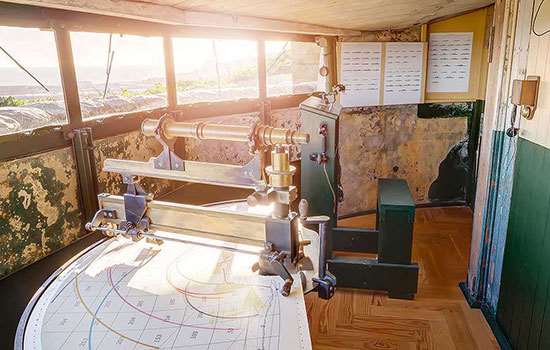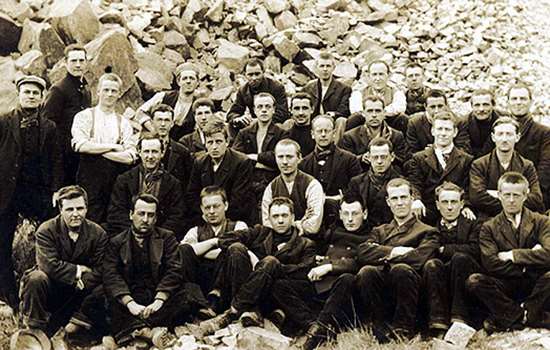The Cenotaph
Standing at the heart of Whitehall, the Cenotaph is the main national memorial to the dead of Britain and the British Empire in the First World War and later conflicts.
The present memorial is not the first on this site. For the London Peace Celebrations of July 1919, Sir Edwin Lutyens designed a temporary structure made of wood and painted canvas. When the parading troops reached the memorial, they saluted the memory of their fallen comrades.
The public immediately took the temporary Cenotaph to its heart. Wreaths and flowers piled up and close to a million people made their pilgrimage to it. ‘You could scarce see the Cenotaph for the aura, the halo, the throbbing air that encompassed it,’ commented the Daily Mail. So a permanent version in Portland stone, also by Lutyens, was erected in time for the Armistice Day parade of 11 November 1920. This also saw the procession of the Unknown Warrior on his final journey to burial at Westminster Abbey.
Lutyens’s austere and dignified design for the Cenotaph rejected imagery, bombast and religious symbolism. Its timeless, non-denominational form has ensured its relevance to all the dead of the Empire and to audiences ever since. Its message was one of the universality of grief and the human cost of victory.
Read more about the history of the CenotaphRoyal Artillery Memorial
This outstanding memorial on the western side of the traffic island at Hyde Park Corner dramatically depicts the horrors of modern warfare. Unveiled in October 1925, it commemorates the 49,076 fatalities suffered by the Royal Artillery in the First World War, in which artillery played an increasingly central role.
The monument’s crowning feature is a 9.2-inch howitzer – one of the main heavy weapons of the Western Front – depicted in Portland stone. Below it, a frieze depicts scenes of the gunners in action. Around the base stand four striking bronze figures of gunners: a corpse draped in an overcoat, a shell carrier, a lieutenant, and a driver with arms outstretched.
The recumbent corpse is a rare feature on British war memorials, which the sculptor, Charles Sargeant Jagger (who had served as an infantry officer), insisted on including. At his suggestion the inscription below the figure reads ‘Here was a royal fellowship of death’, taken from Shakespeare’s Henry V.
Initial reactions to the memorial were mixed. The politician Lord Curzon described the howitzer as ‘a toad squatting, about to spit fire out of its mouth … nothing more hideous could ever be conceived’. But members of the regiment strongly supported its design, and it is now internationally recognised as one of the finest memorials erected anywhere after the First World War.
The image at the top of this page shows the memorial’s north-eastern frieze, which depicts a battery of heavy guns in action.
Machine Gun Corps Memorial
Standing next to the Royal Artillery Memorial, the Machine Gun Corps Memorial, unveiled in 1925, is at first sight one of the most perplexing of British war memorials.
The Machine Gun Corps was formed in 1915 to improve the deployment of machine guns. 170,000 men served in its ranks. It was disbanded in 1922, so the memorial is a tribute to a lost unit as well as to the many thousands of fatalities it had suffered. Known by some as ‘the Suicide Club’, this corps was not for the faint-hearted.
The noted sculptor Francis Derwent Wood was chosen to create the memorial. Its most striking, and seemingly incongruous, feature, placed over depictions of two machine guns, is an exquisite classically inspired nude statue of the young David holding Goliath’s giant sword. The biblical inscription below – ‘Saul hath slain his thousands / but David his tens of thousands’ – refers to the devastating killing power of machine guns.
Derwent Wood’s statue of David was once dismissed by critics as crass in its irrelevance to modern warfare. However, recent research has shown that he had good reason for choosing to depict an idealised human figure alongside the technology of killing. He was a pioneer of facial prostheses, and spent much of the war creating bespoke prosthetic masks to help disguise the wounds of disfigured soldiers. He was therefore better placed than most to understand the terrible impact of modern warfare on the human body.
Field Marshal Earl Haig Memorial
Field Marshal Earl Haig (1861–1928) was Commander-in-Chief on the Western Front from 1915 to 1918, leading the largest British army ever assembled to eventual victory. He remains a controversial figure, because of the huge loss of life in battles such as the Somme, Arras and 3rd Ypres (or Passchendaele).
Prime Minister Stanley Baldwin suggested erecting a monument soon after Haig’s unexpected death in early 1928. The sculptor Alfred Hardiman was chosen to design a realistic portrait, and he depicted Haig – a former cavalry officer – hatless, wearing an open greatcoat over his uniform, and seated on a powerful horse.
Haig’s widow had decided views on the representation of her husband and wanted a more naturalistic horse. Hardiman’s approach ultimately won through, but the complexities of agreeing on the design and manufacturing the costly statue nearly ruined him. The memorial was eventually unveiled on 10 November 1937. Placed close to the old War Office on Whitehall, it was one of the last equestrian statues of military commanders erected in Britain.
Some critics at the time took exception to aspects of the sculpture, such as the stylised horse, Haig’s stiff posture and his bare head. But it is now seen as a powerful example of inter-war classical statuary which strove to reconcile modernity and tradition.
Belgian Gratitude Memorial
One of the most unusual war memorials in London, the Belgian Gratitude Memorial was unveiled in 1920 on the Victoria Embankment, opposite Cleopatra’s Needle. It was a tribute to Great Britain in recognition of the welcome extended to the thousands of Belgian refugees fleeing the German invasion of Belgium in August 1914. The invasion triggered Britain’s entry into the First World War.
The monument’s central feature is a fine bronze group depicting a mourning mother, representing Belgium, urging two garland-bearing children forward. In the words of the sculptor, Victor Rousseau, himself a Belgian refugee in London, she is ‘telling her children that Belgians will never forget their debt of gratitude to Great Britain’. Sir Reginald Blomfield designed the architectural setting, which includes figures of Justice and Honour and the coats of arms of the provinces of Belgium.
The London memorial reflects the impact of conflict on civilian populations, poignantly expressed through the fatherless family group.
Edith Cavell Memorial
Edith Cavell is perhaps the most renowned woman casualty of the First World War. Born in Norfolk in 1865, she was in charge of a training school for nurses in Brussels when war broke out. She refused to leave when the Germans invaded, and soon became involved in an escape line for Allied soldiers and would-be recruits. When caught, she confessed to her deeds and was shot by a firing squad in October 1915. She quickly came to be seen as a martyr for the Allied cause.
Her memorial stands outside the National Portrait Gallery, just north of Trafalgar Square. One of the very earliest memorials of the war, it was commissioned soon after her execution and unveiled in 1920. Edith’s sister posed for the rather idealised marble figure of Cavell, carved by the renowned sculptor Sir George Frampton.
The memorial was unconventional in both subject and design. At the top is a seated group, with the larger figure, representing Humanity, sheltering an infant, representing the smaller states – it was for Belgium and Serbia that Britain had gone to war. The lion on the rear depicts British valour.
The quotation of Cavell’s final message, ‘Patriotism is not enough. I must have no hatred or bitterness for anyone’, was added to the memorial later, when the National Council of Women lobbied to have a less martial note included.
Read more about Edith CavellLegacy
A hundred years on, the sacrifices of the First World War remain heartfelt. In their different ways, these six Great War memorials commemorate the universality of death, the harrowing reality of combat, the vulnerability of human flesh, victorious leadership, the sacrifice of the individual and the debt owed by civilians to the military. They still speak to us of individual and collective losses and act as a focus for commemoration.
The text of this article is drawn from Wellington Arch, Marble Arch and Six Great War Memorials by Roger Bowdler and Steven Brindle, published by English Heritage in 2015.
Buy the guidebookMore First World war history
-

The Armistice Centenary
One hundred years after the Armistice, discover the English Heritage places that have links with the war, and find out about the people associated with them.
-

Wrest Park at War
Wrest Park in Bedfordshire was used first as a convalescent home before being transformed into a base hospital in November 1914.
-

Help us identify forgotten WWI nurses
English Heritage has colourised wartime photographs of nurses who worked at Wrest Park, and is now appealing to their relatives to help identify them.
-

The WWI Stonehenge aerodrome
As they travel from the Stonehenge visitor centre to the stones, few of today’s visitors realise that they’re crossing the site of a WWI airfield.
-

FORTRESS DOVER AND THE FIRST WORLD WAR
Use this virtual tour to explore a building at Dover Castle that played a vital role in safeguarding Dover in the First World War.
-

BATTLEFIELDS TO BUTTERFLIES: A GARDENER AT WAR
Men from all walks of life left their homes, loved ones and jobs to fight, many never to return. Staff at some of the properties now cared for by English Heritage were no exception.
-

The Richmond Sixteen
How 16 First World War conscientious objectors detained at Richmond Castle were taken to France and sentenced to death for refusing to obey orders.
-

Attitudes to Conscientious Objection and Conscription
Find out how conscription came about during the First World War, and what happened to the men who applied for exemption.
